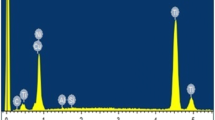Abstract
Grinding is a machining process for removing material from a workpiece by using an expendable grinding wheel. The paper presents, a control system for grinding process using neural network and fuzzy technique. It was discovered that the maximum grinding temperature was very important since too high temperature would lead to surface burns and thermal damage to the grinding wheel as well as the workpiece material. A neuro-fuzzy model was used to analyze the grinding wheel performance index as it affects the general grinding operations of the grinding process. The research work can be applied to any other grinding process, whether wet or dry grinding process.





Similar content being viewed by others
References
Angelov P, Buswell R (2002) Identification of evolving fuzzy rule-based models. IEEE Trans Fuzzy Syst 10(5):667–677
Angelov P, Filev DP (2004) An approach to online identification of Takagi-Sugeno fuzzy models. IEEE Trans Syst Man Cybern B Cybern 34(1):484–498
Baruch IS, Mariaca CR (2009) A levenberg-marquardt learning applied for recurrent neural identification and control of a wastewater treatment bioprocess. Int J Intell Syst 24(11):1094–1114
Canuto A, Howells G, Fairhurst MA (2006) Comparative evaluation of the RePART neuro-fuzzy network. In: 6th workshop on fuzzy systems, New York, pp 225–229
Cox E (1994) The fuzzy system handbook. AP Professional, New York
Crawford S (1979) Basic engineering processes. Rolls-Royce Technical College, Bristol, Printed by W.J. Arrowsmith. Ltd, Bristol
Curry AC, Shih AJ, Scattergood RO, Kong J, McSpadden SB (2003) Grinding temperature measurements in MgO, PSZ, using infrared spectrometry. J Am Ceramic Soc 86(7):333–341
Dhar NR, Siddiqui AT, Rashid MH (2006) Effect of high-pressure coolant jet on grinding temperature, chip and surface roughness in grinding Aisi-1040 steel. J Eng Appl Sci 1(4):22–28
Diniz AE, Marcondes FC, Coppini NL (2000) Technology of the machining of materials, 2nd edn. Artiliber Publisher Limited, Campinas, Brazil
Haykin S (1998) Neural networks: a comprehensive foundation, 2nd edn. Prentice Hall, Engelwood Cliffs
Iglesias JA, Angelov P, Ledezma A, Sanchis A (2010) An evolving classification of agents behaviors: a general approach. Evol Syst 1(3):161–172
Leite D, Ballini R, Costa P, Gomide F (2012) Evolving fuzzy granular modeling from nonstationary fuzzy data streams. Evolv Syst 3(2):65–79
Lemos A, Caminhas W, Gomide F (2011) Multivariable Gaussian evolving fuzzy modeling system. IEEE Trans Fuzzy Syst 19(1):91–104
Li B, Ye B, Jiang Y, Wang T (2005) A control scheme for grinding based on combination of fuzzy and adaptive control techniques. Int J Information Technol 11(11):70–77
Malkin S, Ritter PE (1989) Grinding technology: theory and applications of machining with abrasives. Ellis Horwood Limited Publishers, Chichester, Halsted Press: a division of Wiley
Mehrotra K, Mohan CK, Ranka S (1997) Elements of artificial neural networks. The MIT Press, Cambridge
Odior AO (2002) Development of a grinding wheel from locally available materials. J Nigerian Inst Product Eng 7(2):62–68
Odior AO, Oyawale FA, Charles-Owaba OE, Akpobi JA (2010) Manufacture of abrasive grinding wheel using silicon carbide abrasive materials. J Eng Dev 9:54–64
Radford JD, Richardson DB (1978) Production technology, 2nd edn. Edward Arnold, London
Rubio JJ, Ortiz JJ, Mariaca FCR, Tovar JC (2011) A method for online pattern recognition of abnormal eye movements. Neural Comput Appl. doi:10.1007/s00521-011-0705-4. http://link.springer.com/journal/521
Rubio JJ, Angelov P, Pacheco J (2011) Uniformly stable backpropagation algorithm to train a feedforward neural network. IEEE Trans Neural Netw 22(3):356–366, ISSN: 1045-9227
Ruspini E, Bonissone P, Pedryez W (1998) Hand book of Fuzzy Computation. Ed. Iop Pub/Institute of Physics, Williston
Shih AJ, Curry AC, Scattergood RO (2003) Grinding of zirconia using the dense vitreous bond silicon carbide wheel. J Manuf Sci Eng 125(4):297–303
Stephenson DJ, Sun X, Zervos C (2006) A study on Elid ultra precision grinding of optical glass with acoustic emission. Int J Mach Tools Manuf 46:1053–1063
Wasserman PD (1989) Neural computing. Van nostrand Reinhold, New York
Zadeh LA (1988) Fuzzy logic. IEEE Computer 21:83–92
Yu W, Moreno MA, Ortiz F (2007) System identification using hierarchical fuzzy neural networks with stable learning algorithm. J Intell Fuzzy Syst 18(2):171–183
Zadeh L (1965) Fuzzy sets. Inf Cont 8:338–353
Author information
Authors and Affiliations
Corresponding author
Rights and permissions
About this article
Cite this article
Odior, A.O. Application of neural network and fuzzy model to grinding process control. Evolving Systems 4, 195–201 (2013). https://doi.org/10.1007/s12530-013-9073-x
Received:
Accepted:
Published:
Issue Date:
DOI: https://doi.org/10.1007/s12530-013-9073-x




